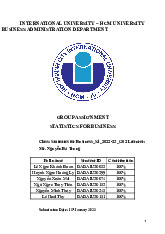


Preview text:
1. A research study showed that 7 percent of “A” students smoke, while nearly
50 percent of“D” students do.
(a) List in rank order six factors that you think affect grades. Is smoking on your list?
(b) If smoking is not a likely cause of poor grades, can you suggest reasons why these results were observed?
(c) Assuming these statistics are correct, would “D” students who give up smoking
improve their grades? Why or why not?
2. The Graduate Management Admission Test (GMAT) is used by many
graduate schools of business as one of their admission criteria. GMAT scores
for selected undergraduate majors are shown
below. Using your own reasoning and concepts in this chapter, criticize each of the following statements.
a. “Philosophy majors must not be interested in business since so few take the GMAT.”
b. “More students major in engineering than in English.”
c. “If marketing students majored in physics, they would score better on the GMAT.”
d. “Physics majors would make the best managers.”
3. (a) Which of these two displays (table or graph) is more helpful in
describing the salad sales by Noodles & Company? Why? (b)
Write a one-sentence summary of the data Answer : 1.
a. Attendance, study time, ability level, interest level,instructor’s ability, prerequisites.
b. Reverse causation? Good students make better decisions about their health. c. No, causation is not shown 2.
A major problem is that we don’t know number of students in each major.
a. Likely fewer philosophy majors to begin with.
b. Likely more engineers want an MBA, so they take it.
c. Causation not shown. Physics may differ from marketing majors (e.g., math skills).
d. The GMAT is just an indicator of academic skills. 3.
a. Most would prefer the graph, but both are clear.
b. The number of salads sold reached a maximum in May
and decreased steadily toward the end of 2005.




